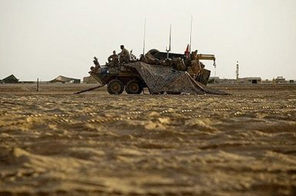Military operation in Afghanistan
NAWA: Thousands of U.S. Marines and hundreds of Afghan troops poured into Taliban-infested villages of southern Afghanistan with armor and helicopters Thursday in the first major operation under President Barack Obama's strategy to stabilize the country.
The offensive in the once-forgotten war was launched shortly after 1 a.m. Thursday local time in Helmand province, a Taliban stronghold and the world's largest opium poppy producing area. The goal is to clear insurgents from the hotly contested region before the nation's Aug. 20 presidential election.
Officials described the operation, dubbed Khanjar, or "Strike of the Sword," as the largest and fastest-moving of the war's new phase, involving nearly 4,000 of the newly arrived Marines and 650 Afghan forces. British forces last week led similar, but smaller, missions to clear out insurgents in Helmand and neighboring Kandahar provinces.
"Where we go we will stay, and where we stay, we will hold, build and work toward transition of all security responsibilities to Afghan forces," Marine Corps Brig. Gen. Larry Nicholson said in a statement.
Transport helicopters carried hundreds of Marines into the village of Nawa, some 20 miles (30 kilometers) south of the provincial capital of Lashkar Gah, in a region where no U.S. or other NATO troops have operated in large numbers.
Daybreak brought the sporadic crackle of gunfire, but no heavy fighting immediately broke out. Medical helicopters circled overhead and landed, indicating possible early casualties among the Marines.
A roadside bomb early in the mission wounded one Marine, but he was able to continue, spokesman Capt. Bill Pelletier said.
Southern Afghanistan is a Taliban stronghold but also a region where Afghan President Hamid Karzai is seeking votes from fellow Pashtun tribesmen.
The Pentagon is deploying 21,000 additional troops to Afghanistan in time for the elections and expects the total number of U.S. forces there to reach 68,000 by year's end. That is double the number of troops in Afghanistan in 2008, but still half of much as are now in Iraq.
The Taliban, who took control of Afghanistan in 1996 and were ousted from power following a U.S.-led invasion in 2001, have made a violent comeback, wreaking havoc in much of the country's south and east, forcing the United States to pour in the new troops.
Pelletier said troops in Thursday's operation were sent in by a mixture of aircraft and ground transport under the cover of darkness.
The operation aims to show "the Afghan people that when we come in we are going to stay long enough to set up their own institutions," Pelletier said.
Once on the ground, the troops will meet with local leaders, hear their needs, and act on them, Pelletier said.
"We do not want people of Helmand province to see us as an enemy, we want to protect them from the enemy," Pelletier said.
"We are kind of forging new ground here. We are going to a place nobody has been before," said Capt. Drew Schoenmaker, 31, from Greene, New York, who commands Bravo Company of the 1st Battalion, 5th Marine Regiment.
Reversing the insurgency's momentum has been a key component of the new U.S. strategy, and thousands of additional troops allow commanders to push and stay into areas where international and Afghan troops had no permanent presence before.
While Marine troops were the bulk of the force, recently arrived U.S. Army helicopters were also taking part in the operation in Helmand province.
In March, Obama unveiled his strategy for Afghanistan, seeking to defeat al-Qaida terrorists there and in Pakistan with a bigger force and a new commander. Taliban and other extremists, including those allied with al-Qaida, routinely cross the two nations' border in Afghanistan's remote south.
The governor of Helmand province predicted the operation would be "very effective."
"The security forces will build bases to provide security for the local people so that they can carry out every activity with this favorable background, and take their lives forward in peace," Gov. Gulab Mangal said in a Pentagon news release.
Obama aims to boost the Afghan army from 80,000 to 134,000 troops by 2011 — and greatly increase training by U.S. troops accompanying them — so the Afghan military can take control of the war. The White House also is pushing forces to set clear goals for a war gone awry, provide more resources and make a better case for international support.
There is no timetable for withdrawal, and the White House has not estimated how many billions of dollars its plan will cost.






